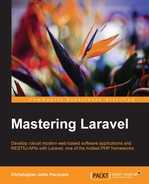Book Description
Develop robust modern web-based software applications and RESTful APIs with Laravel, one of the hottest PHP frameworks
In Detail
PHP continues to revive and Laravel is at its forefront. Laravel follows modern PHP's object-oriented best practices and reduces time-to-market, enabling you to build robust web and API-driven mobile applications that can be automatically tested and deployed.
With this book you will learn how to rapidly develop software applications using the Laravel 5 PHP framework.
This book walks you through the creation of an application, starting with behavior-driven design of entities. You'll explore various aspects of modern software including the RESTful API, and will be introduced to command bus. Laravel's annotations package is also explained and demonstrated. Finally, the book closes with a demonstration of different ways to deploy and scale your applications.
What You Will Learn
- Convert specifications into classes and functions, using a specification-based behavioral-driven design (BDD)
- Create a deployment script for a continuous delivery environment
- Use Eloquent to interact with the database in an object-oriented manner
- Easily scale software with route caching and the read/write configuration
- Use DocBlock annotations to enhance controllers and reduce the amount of code required
Downloading the example code for this book. You can download the example code files for all Packt books you have purchased from your account at http://www.PacktPub.com. If you purchased this book elsewhere, you can visit http://www.PacktPub.com/support and register to have the files e-mailed directly to you.
Table of Contents
- Mastering Laravel
- Table of Contents
- Mastering Laravel
- Credits
- About the Author
- About the Reviewers
- www.PacktPub.com
- Preface
- 1. Designing Done Right with phpspec
- 2. Automating Tests – Migrating and Seeding Your Database
- 3. Building Services, Commands, and Events
- 4. Creating RESTful APIs
- 5. Using the Form Builder
- 6. Taming Complexity with Annotations
- 7. Filtering Requests with Middleware
- 8. Querying the Database with the Eloquent ORM
- 9. Scaling Laravel
- 10. Building, Compiling, and Testing with Elixir
- Index
